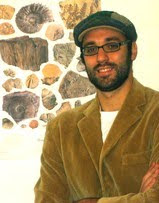The Mid-Atlantic Ridge is one of the most impressive geological features of our planet. Extending for more than 40,000 km, it represents one of the major tectonic boundaries of the Earth. In fact, at the Mid-Atlantic Ridge humongous volcanic phenomena form new crustal material, separating different tectonic plates.
 |
| Relationship between the Mid-Atlantic Ridge and Iceland. |
Unfortunately for geologists, the Mid-Atlantic Ridge is usually placed at considerable dephts, preventing direct observations. In this regard, Iceland represent a unique place because it consists of a segment of the Mid-Atlantic Ridge that rises above the ocean surface.
Björk is another phenomenon that erupted from the wild geological landscapes of Iceland.
Known for her eclectic musical style and a distinctive voice, Björk is among the most enduringly popular musician of modern times.
 |
| The cover of Biophilia. From www.bjork.com |
It makes no surprise that an artist born on the Mid-Atlantic Ridge realized geological music. Indeed Björk recently released Biophilia, a musical project including strong geological references. In particular, 'Crystalline' portrays an aethereal mineralogical universe. The video features crystal growth and a meteor shower.
Crystalline video.
 |
| Crystalline app. From Pasta&Vinegar. |
Analogously to the other tracks of Biophilia, Crystalline is accompanied by an interactive application. IPad lovers can plunge into a geometric world, somehow reminescent of the celebrated videogame Rev.
Nevertheless, there is even a more explicit geological reference in Björk's new album: Mutual Core. It is a geological hymn narrating the inner mechanisms of our planet.
Mutual Core includes strong references to the homeland of Björk, the emerged segment of the Mid-Atlantic Ridge:
I shuffle around
The tectonic plates
In my chest
You know I gave it all
Try to match our continents
To change seasonal shift
To form a mutual core
As fast as your fingernail grows
The Atlantic Ridge drifts
To counteract distance
- Björk, Mutual Core
At the Befestival 2011, Björk performed a live version of Mutual Core, including amazing visuals. The visual performance dramatically shows continental drift in action: tectonics and paleogeography in art.
Björk performing Mutual Core. The lyrics and the visuals are explicitely geological.









